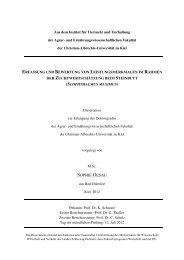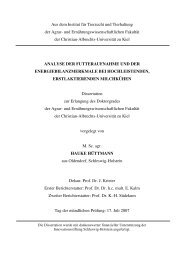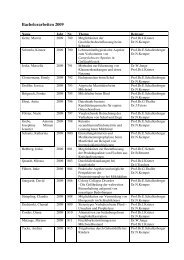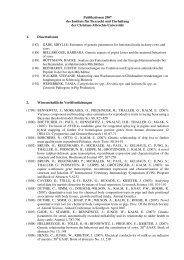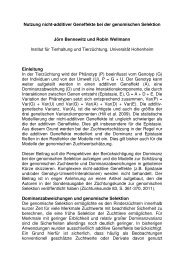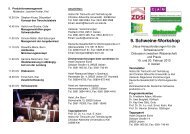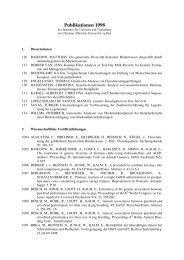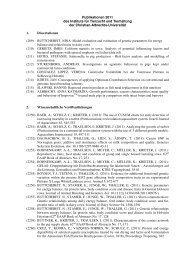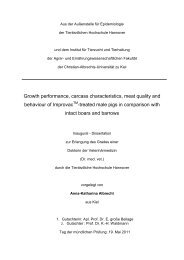Verena Gonzalez Lopez, 2011 - Institut für Tierzucht und Tierhaltung ...
Verena Gonzalez Lopez, 2011 - Institut für Tierzucht und Tierhaltung ...
Verena Gonzalez Lopez, 2011 - Institut für Tierzucht und Tierhaltung ...
Erfolgreiche ePaper selbst erstellen
Machen Sie aus Ihren PDF Publikationen ein blätterbares Flipbook mit unserer einzigartigen Google optimierten e-Paper Software.
where a i is the proportion of known ancestors in generation i and d the number of<br />
generations that is taken into account.<br />
In addition, known ancestors were used to compute the complete generation<br />
equivalent for each individual j as<br />
n<br />
j<br />
∑<br />
1 ,<br />
gij<br />
i=<br />
1 2<br />
where n j is the number of ancestors of individual j, and g ij is the number of<br />
generations between individual j and its ancestor i (Boichard et al., 1997). Finally, the<br />
maximum number of generations traced was obtained as the number of generations<br />
between an individual and its most distant known ancestor. The calculations were<br />
carried out for the whole pedigree file as well as for each population.<br />
Inbreeding and average degree of relationship<br />
The individual inbreeding coefficient (F) is defined as the probability that an individual<br />
has two identical alleles by descent (Wright, 1931). The additive genetic relationships<br />
among all pairs of animals and the individual coefficients of inbreeding were<br />
computed based on the numerator relationship matrix (NRM). Furthermore, the<br />
average relationship coefficient (AR) for each individual was calculated as the<br />
average of the coefficients in the row corresponds to the individual in the NRM. The<br />
AR is defined as the probability that an allele randomly chosen from the whole<br />
population is present to a given animal (Gutiérrez et al., 2003).<br />
Measure of connectedness<br />
In this study different methods were applied to describe the degree of connectedness<br />
between the herdbook populations.<br />
1) Number of common boars<br />
The number of boars in common in two or more herdbook organizations is also used<br />
by Weigel et al. (2000) and Thorén Hellsten et al. (2008) as a measure of genetic<br />
connectedness in cattle and horses.<br />
2) Genetic similarity (GS)<br />
The genetic similarity is a relative measure and was computed as the proportion of<br />
progeny of boars with progeny in two herdbook populations, relative to the total<br />
23



